सटीक नाइट्रोजन उर्वरक प्रबंधन के लिए आधुनिक उपकरण और तकनीक
Food production is commensurate with fertilizer usage. Among the three major fertilizers, nitrogen, phosphate and potassium, application of nitrogenous fertilizers is the maximum.
It is reported that China, India and Pakistan together consume approximately 70% of nitrogen fertilizer consumed globally. These figures of nitrogen fertilizer consumption point towards emerging environmental pollution issues.
The estimated food production demands would require application of N fertilizer to the tune of 116.0 million tonnes in 2016 and 58% of it would be required in Asia alone of which India’s share would be 30% (FAO Report, 2012).
The consumption of N fertilizer in form of urea has increased many folds after green revolution in India which is mainly due to lacunae in soil testing facilities for a large number of small-holder marginal farmers which are mostly unaware about modern tools and techniques.
The only guiding tool for the farmers is their own wisdom while applying urea and other pesticides and inputs.
Often they end up following wrong package of practices as they have no scientific tools to measure what the soil is deficient in.
India imported about 10.24 million tonnes (about 41% of total consumption) of fertilizer nutrient NPK in 2008-09 as against 1.93 million tonnes in 2002-03.India produces 10% of world fertilizer and 20% of total N consumption is met by import and hence causes highexpenditure to the nation (FAOSTAT 2013).
This loss of national currency in importing Nfertilizers is justified by following figures and data of FAO of United Nations and Govt. of India which clearly shows that urea subsidy has been alarming and has increased tremendously from year 2006-07 to 2013-14 without any significant increase in cereal production in this period.
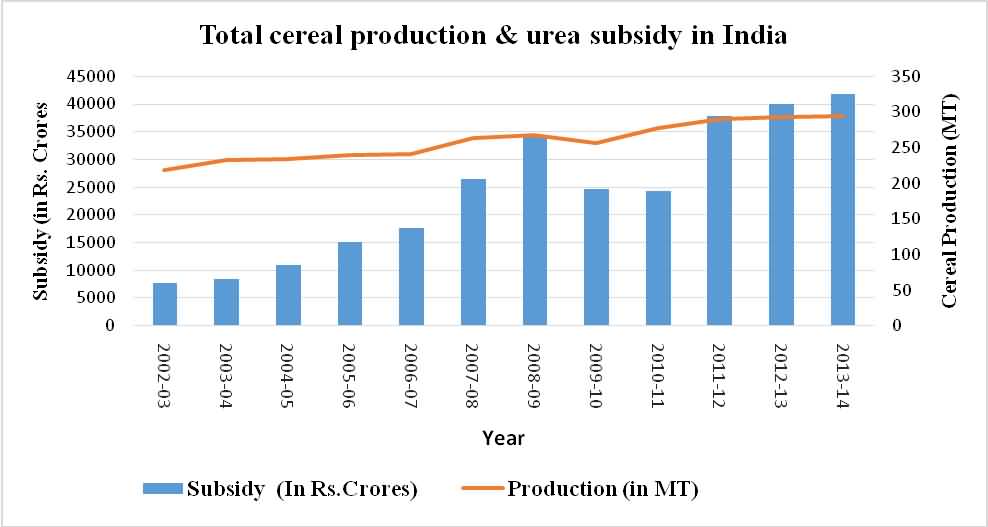
The almost static cerealsproduction as against increasing subsidy on N fertilizers shows that there is undue use of fertilizers specially urea.
Factors responsible for excess use of N fertilizers in India:
The long term factors for increasing fertilizer consumptionare raising world population and need for nutritious food. Besides the above inevitable factorsthe other reasonsare as follows:
Unscientific method of fertilizer application:
Indian agriculture practices are coming from ancient times and depends mainly on conventional methods of fertilizer application like broadcasting alone or mixed with seeds manually.
This method is unscientific and on one hand leads to consumption of excessive fertilizer quantity that the required or recommended levels and on the other hand leads to leaching and runoff losses.
Lack of awareness:
Most of the farmers are uneducated and unaware of modern tools and techniques used in agriculture. Lack of awareness of knowledge may be due to illiteracy, not being in touch with extension services provided by universities, print and electronic media.
Nutrient status:
There is lot of variations in soil type and health because of vast area and different topographies of the country. Even at district level there are tremendous variations in soil nutrient status. Hence, a majority of farmers do not know the soil nutrient status and also unaware of the importance of knowing it. Application of fertilizers without knowing the soil nutrient supplying ability also leads to excess use and wastage of fertilizers.
Greediness:
As increased application of N increases overall biomass and healthiness of crop canopy and gives an impression of attractive dark green attractive look. Hence, farmers unnecessarily apply overdose of N only for the sake of high biomass, yield and money.
Availability of urea at subsidised prices act as an adding factor to the problem.
Consequences of excess use of urea (N):
Effect on soil microflora:
The beneficial microorganism present in the soil are the greatest gift and invaluable asset given by nature. These soil microorganism makes the soil productive and maintains its fertility status by many biological processes.
Blind and excessive use of urea and other chemical fertilizers affect these invaluable soil microflora and the result is unproductive land with less or no water holding capacity.
Water and air contamination:
At commercial level, urea is a synthesised by liquid ammonia and CO2 at very high temperature and pressure.The carbon of urea fertilizers is converted into CO2 and lost into the environment causing air pollution.
Only up to 40-50% of the fertilizer N is recovered in the grain of the applied urea. The rest is lost in the environment in form of leaching, drainage and denitrification. The nutrients lost by runoff and leaching due to unscientific and excessive application of chemical fertilizers also adds to environmental pollution.
This excess N reaches water bodies destroying flora and fauna and causes many deadly diseases to human beings.
Disease susceptibility:
Excess use of N fertilizers than the recommended levels increases tissue succulency in crop plants and make them susceptible to diseases and pests. The increased condition succulency of plant tissues helps in pests and pathogens entry and multiplication easier therefore increasing the susceptibility.
Cost of cultivation:
Synthetic fertilizers are industrially produces and hence comes with a heavy cost than naturally available biological fertilizers. Although the subsidy on fertilizers reduces the burden but indirectly the overall cost is born by all of us in the form of taxes.
Due to higher disease susceptibility caused by excessive urea application, the farmers also have to spend a lot of money on pesticides and fungicides and thus further ads to cost of cultivation.
As farmers are guided by own wisdom and practices of fellow farmers when it came to application manures and pesticides. They often have no idea what is the soilsinherent capacity to supply nutrients and at what it is deficient in and often end up following the wrong practices.
Hence, it is very essential to have knowledge on economic and efficient use of nitrogenous fertilizers so that many adverse effects of excess N usage on living organismsmay be avoided without compromising on yield.
A large number of new technologies have evolved and are continuously being used in educating farmerson economic use of nitrogen fertilizers and some of these tools and techniques are discussed below for the benefits of farmers.
Tools available for N management wheat:
1. NDVI (Normalized Difference in Vegetative Index) Sensor or Green Seeker:
NDVI is a handheld device which uses light emitting diodes to generate red and near infrared light which are used to calculate NDVI values.
Working Principle:
Green Seeker calculates NDVI using red and NIR (Near Infra-Red) light. It is based on simple principle that red light is absorbed by plant chlorophyll as an energy source during photosynthesis. Therefore, healthy plants absorbs more red light and reflect larger amounts of NIR than those that are unhealthy and thus gives higher NDVI value.
NDVI is calculated using the equation:
NDVI = NIRreflected– Redreflected /NIRreflected + Redreflected
Green Seeker is an excellent indicator of biomass (amount of living plant tissue) and is used to accurately project yield potential.
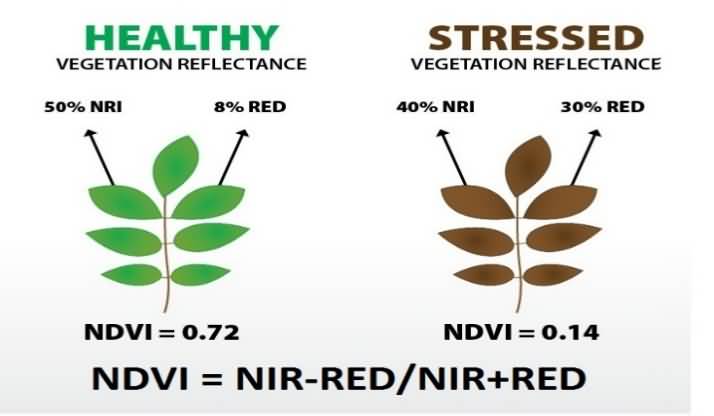
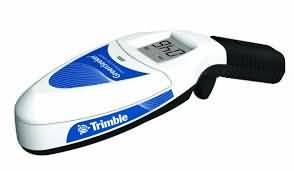
NDVI in Nitrogen Management:
NDVI is commonly used to measure plant health and vigor. By using Green Seeker, we can apply the right amount of N at the right place and at the right time thereby optimizing yield and N input. The instrument is handy and is also available through online retailers in India costing about four to five lakhs per unit. This amount seems too high for the small farmers but it will be compensated in the course of time in the form of Nitrogen saving.
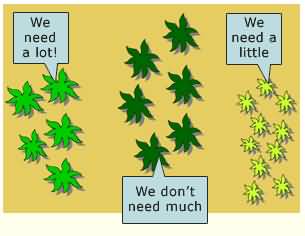
2. Nutrient Expert® (NE) for Wheat:
Nutrient Expert®is a computer based, easy to use, interactive decision support software for site specific nutrient management (SSNM) especially for wheat and small holder farmers designed and developed by International Plant Nutrition Institute (IPNI), USA.
Requirements to use this DSS:
The software needs only the basic computer knowledge by the user and is a boon for farmers in remote areas of world where no soil testing facilities are available for the farmers.
It is a simple and easy to use software and can be used by extension personnel or the farmers itself for site specific nutrient management without undergoing any soil test or sophisticated data. The only need is previous crop management data which is not so sophisticated and the software gives the recommended doses of N as output on basis of input data.
NE uses data which is simple, easily available and not so comprehensive and is as follows:
- Growing environment: The environment plays a vital role in crop growth and health. The growing temperature (hot, cool, dry) and water availability (irrigated, fully rainfed, rainfed with supplemental irrigation) and occurrence of flooding or drought.
- Soil fertility indicators: Soil texture (loam, sandy, and clay), soil color (black, red, gray) and organic matter content soil test history for NPK. Historical use of organic materials (if any), soil problem (salinity, alkanality etc.).
- Crop sequence in the farmer’s cropping pattern in last 2-3 years i.e. crop taken by farmer in the field in recent past.
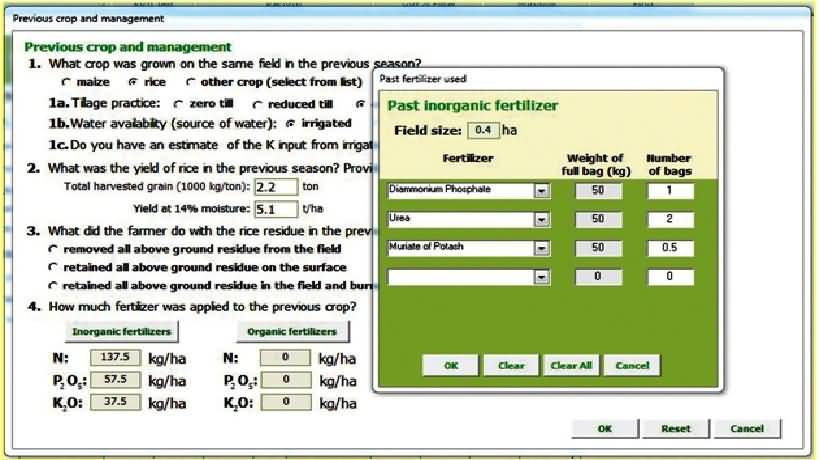
- Crop residue management of previous crops: Crop residue plays an important role in soil fertility and health. Sometimes farmers burnt the whole straw to save time for early planting the next crop or to take 3-4 crops in a year. Crop residue management figures like removal of all above ground residue, retained all above ground residue, ploughed all residue, burnt all above ground residue.
- Farmer’s yield and dose of fertilizers: Current yield and dose of fertilizers and insecticides in past 2-3 months.
- (f) NDVI data.
Based on input data, the software gives the recommended dose and time of fertilizers (organic, inorganic or micronutrient) applications for the specific crop or field.
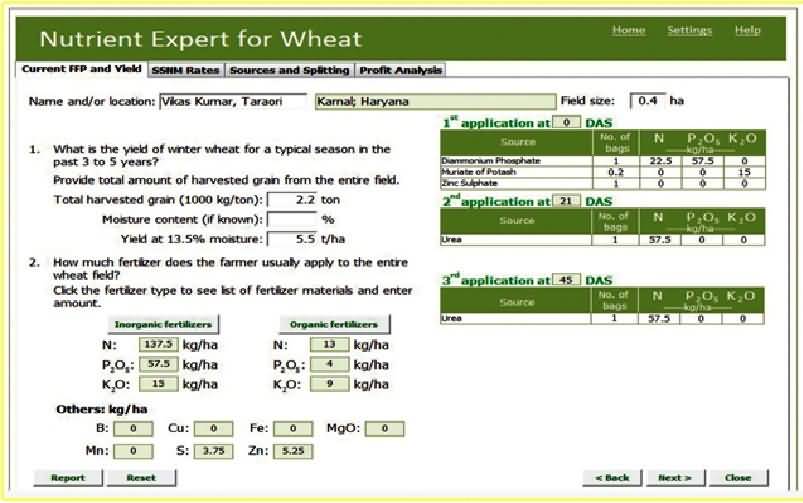
By using NE over Farmer Fertilizer Practices (FFP) the input value can be reduced and nutrient can be saved up to 30 kg/h without compromising yield.
Besides these tools there are many other management practices which are helpful in precise N management and are discussed below:
1. Leaf Color Chart (LCC):
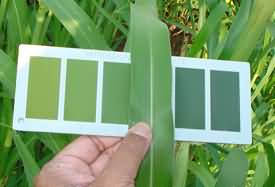
The leaf colour chart (LCC) primarily developed for rice, is a tool to rapidly assess leaf N status at crop growth stages and thereby guide the application of fertilizer N to maintain optimal leaf N content, which is vital for achieving higher yields.
LCC for wheat is under development and being standardized for a number of varietiesby Punjab Agricultural University, Ludhiana.
By matching the leaf color of their crop from 10-12 randomized sites in their field (bypassing the diseased plants) with the color of chart; farmers can find the required dose of fertilizers application at specific site or plant.
By using standard leaf color chart we can predict the amount of N required in the field or the individual plant. This will have a check on the undue use of urea in the field.
2. Neem coated urea & slow releasing urea:
By using neem coated urea we can reduce the cost onurea input and also reduce the input cost of insecticides as neem is a natural insecticide. Hence, we can reduce the import of urea as it reduces the leaching of N in the soil and denitrification process.
We can also use the synthetic polymers which reduces leaching as the water has to go through the small pores of polymer to reach the urea granules and also decreases the volatile nature of urea.

3. Using inhibitors:
Urease is the compound which enhances the denitrification process.
CO(NH2)2 + H2O + urease → 2NH3 +CO2
This ammonia is a gas and readily escapes into environment causing N losses.Urease inhibitors are one class of compounds that prevents this conversion. Hydroquinone is one such Urease inhibitor which reduces the Methane and Nitrous Oxide gas emission in water logged conditions.
4. Split application of fertilizer:
Split application of Nitrogen fertilizer to meet the immediate crop growth stage specific N needs is recommended for maximum N use efficiency with reduced losses. Splitting the total N into two doses, half as basal dose and rest as top-dressing in case of heavy soil types is recommended.
5. Fertigation:
Recent methods of application like fertigation would help in increasing the nutrient use efficiency along with reducing the losses. Fertigation is a method of fertilizer application in which fertilizer is incorporated within the irrigation water by the drip system. In this system fertilizer solution is distributed evenly in irrigation. The availability of nutrients is very high therefore the efficiency is more.
In this method liquid fertilizer as well as water soluble fertilizers are used. By this method, fertilizer use efficiency is increased from 80 to 90 per cent. Practicing fertigation is beneficial to farmers in timely and site specific application of nutrients.
Application of exact quantity of fertilizers according to soil nutrient status based on soil tests will not only result in proper supply of deficient nutrient elements essential for profitable crop production but also saves cost by supply of precise amount of nutrients as per the nutrient supplying capacity of the soil.
6. New Initiatives:
New schemes like Soil health cards (launched in February, 2015) by Govt. of India to improve the soil health of the individual farmer’s land.
Under the scheme a detailed analysis of samples of soil collected from land held by individual farmers is done in various soil testing labs across nation for water content, presence of elements such as potassium, nitrogen, phosphorous, copper, iron and zinc, as well as pH and salinity levels, clay content and water retention capacity.
Advice on handling particular kinds of soil are then handed over in form of soil health cards to the farmers to serve as a guiding tool to apply fertilizersfor various crops. Mobile van soil testing facility is also available under the scheme
Biotechnology to improve NUE:
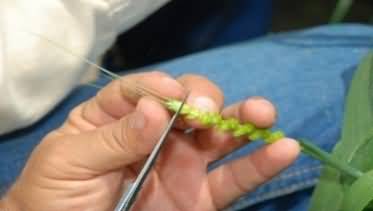 Development of high yielding wheat varieties with improved NUE:
Development of high yielding wheat varieties with improved NUE:
1. Introgression of NUE(Nitrogen Utilisation Efficiency) traits from wild relatives:
The modern high yielding varieties can be crossed with wild relatives for introgression of NUEtraits in the modern cultivars for a high yielding nutrient efficient variety.
2. Development of transgenic wheat (Transfer of NUE genes):
A lot of research has been done in identifying the genes associated with increased NUE in plants. Hence, by using modern biotechnological tools gene of interest amplified and inserted into the plants.
The resultant plants would be more Nitrogen efficient and thus economic and environment friendly.
Conclusion:
Urea and other nitrogenous fertilizers are the need of the hour due to increased population and nutritional demand, but not at the cost of environmental health and life of living organisms.
The blind use of urea is only due to lack of scientific knowledge, poor management practices, illiteracy among farmers. Hence for sustainable livelihood of our future generations and for reduction of money spent on import of fertilizers; we have to adapt modern tools like Nutrient Expert, NDVI sensor and leaf colour chart for proper management of fertilizers.
References:
- www.fao.org/worldfoodsituation/csdb/en
- Alexandratos, N. and J. Bruinsma. 2012. World agriculture towards 2030/2050: the 2012 revision. ESA Working paper No. 12-03. Rome, FAO.
- Park S., Croteau P., Boering K.A., Etheridge D.M., Ferretti D., Fraser P.J., Kim K-R, Krumme P.B., Langenfelds R.L., Ommen T.D.V, Steele L.P., and Trudinger C.M., 2012.“Trends and seasonal cycles in the isotopic composition of nitrous oxide since 1940.” Nature Geoscience 5(4): 261–265.
- Olson, R.V. and C.W. Swallow. 1984. Fate of labelled nitrogen fertilizer applied to winter wheat for five years. Soil Sci. Soc. Am. J. 48:583-586.
- Current world fertilizer trends and outlook to 2016: FAO Rome (2012)
- Cameron K.C., Di H.J., Moir J.L. (2013) Nitrogen losses from the soil/plant system: a review. Annals of Applied Biology, 162, 145–173.
Authors
Ravinder Kumar, Girish Chandra Pandey, Mamrutha HM, Nagaraja NR and K. Venkatesh
Indian Institute of Wheat and Barley Research, Karnal, Haryana-132001
*E-mail:
